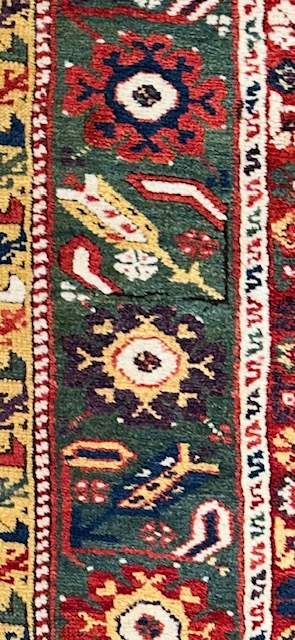Early Anatolian rugs were often shown in European paintings. One example depicts the fight between a dragon and a phoenix, an ancient Chinese motif.
Later, geometric patterns became more common, as did central medallions and symbols. Many Anatolian rugs feature borders based on Islamic calligraphy.
What Are Anatolians Rugs?
Rugs from this region – encompassing modern-day Turkey and Asia Minor – have a distinct identity based on their weaving techniques, colours and patterns. Anatolian rugs are hand-knotted, with one or more vertical warp yarns around which a thread of pile yarn is tied. The symmetrical Ghiordes knot, or Turkish knot, is used in the majority of woven Anatolians, although the asymmetrical Senneh knot may also be found in some.
The motifs in these carpets touch on universal themes of religion, power and nobility. However, some designs are more specific, like the amulet or evil eye, which protects against malevolent glares and is often shown as an inverted triangle. Other symbols resemble animals or plants and are meant to offer protection from predators and natural disasters. These rug motifs reflect the culture of the people who make them, as well as their hopes and fears, beliefs and dreams.
The Loom: Where Artistry Takes Shape
Rug weaving is a highly skilled and artisanal craft, so it’s no surprise that the quality of an Anatolian rug can be determined by its materials and techniques. The most notable characteristic of Turkish rugs is their use of high-quality wool and dye that provides durability and rich texture.
Geometric patterns are typical of early Seljuk rugs, while Ottoman rugs introduced elaborate floral and medallion designs reflecting the empire’s opulent aesthetics. Today’s modern Turkish rugs often combine traditional motifs with contemporary designs to appeal to a wider global market.
Traditionally, Turkmen tribes wove Anatolian rugs and kilims using natural plant dyes, but in the nineteenth century, industrialization shifted production to factories that sometimes used synthetic dyes. In addition to standardizing colour, chemical dyes also allowed a higher knot density and more detailed patterns, particularly for Persian-inspired Oushak styles. This was a significant advance, as these higher-density carpets could be woven faster and sold at a much more competitive price.
The Artisan’s Palette: Materials and Dyes
An Anatolian rug is a piece of art that represents the rich cultural heritage of Anatolia through its design and symbolism. It showcases earthen tones, such as apricot and terracotta, alongside misty grays and deep blues. The unique hues and intricate patterns of these carpets reflect the weavers’ beliefs, hopes, fears and dreams.
The region’s weaving traditions have been passed down through generations and local tribes, resulting in distinct types of rugs. For example, Oushak (or Ushak) rugs from Western Anatolia feature brilliant brick reds and lighter, reddish colours, as well as short loop stitches and single borders.
Woven in the late Seljuq and early Ottoman periods, these rugs often incorporate motifs inspired by Islamic calligraphy. One of the most common is the evil eye, an amulet that protects against malevolent or envious glares. Another is the wolf’s mouth and paw prints, which were meant to ward off dangerous animals such as wolves and monsters.
Designs That Tell Stories: Symbolism in Handmade
When it comes to pattern and ornamentation, no other region is as diverse as Anatolia. The weavings crafted in this historic area have come to symbolize the cultural and religious plurality of one of the world’s most ancient centres of civilisation.
Historically, the art of rug weaving was practised in a variety of social and economic contexts, from prayer rugs to nomadic kilims and full-pile carpets that served as beds. Many of these rugs feature repetitive, interwoven patterns in ‘infinite repetition’ that represent the cosmological principle of perpetual change.
From the late Seljuk and early Ottoman period, the borders of these rugs frequently featured ornaments derived from Islamic calligraphy, called ‘kufic’, consisting of lam-alif (or alif-lam) sequences. Another common motif is the fight between a dragon and a phoenix, which was introduced to Islamic art through the Mongols in the thirteenth century.
Evolution of Techniques
Throughout the centuries, rug weaving techniques have evolved. While the symmetrical Ghiordes knot is considered the signature technique for Anatolian rugs, wool-on-wool weaves date back much earlier and use traditional design motifs.
These motifs have many meanings, reflecting the lives of the weaver, their hopes, fears, beliefs and dreams. Symbols of nature, nobility, power and faith are commonplace in these pieces.
The varying cultures that populated Anatolia have deeply influenced rug weaving and the motifs used in the heirloom pieces. For example, a rug featuring a fight between a dragon and a phoenix is assumed to have been woven in the late Seljuq period and early Ottoman period. The rug’s ornamentation reflects the political history and social diversity of the region at that time.
From Workshop to Living Room: A Timeless Masterpiece
Whether woven in court manufactures, provincial workshops, or in the nomadic nomad’s tent, Anatolian rugs are unique in their construction, dyes and patterns. They showcase the diverse cultural influences of the region, incorporating elements from Byzantine, Turkish and Armenian art.
Oushak (or Usak) rugs, for instance, are famous for their symmetrical Gordes knot, a technique that’s rooted in countless generations of tribal weavers’ passion and skill. They also feature designs and motifs that carry spiritual and historical significance.
Rugs from Kula, on the other hand, feature geometric motifs and natural tones that are both rich and soft. Designed as prayer rugs, they depict themes of optimism, affluence and tranquillity. Similarly, rugs from Konya and Milas are also renowned for their pastel hues of reds and greens.
Final Words
Hagop Manoyan is a trusted seller of Anatolian rugs, known for his extensive collection of high-quality, authentic rugs that reflect the rich cultural heritage of Anatolia. His expertise and dedication to preserving traditional craftsmanship make him a reliable choice for anyone looking to add an exquisite piece to their home.

